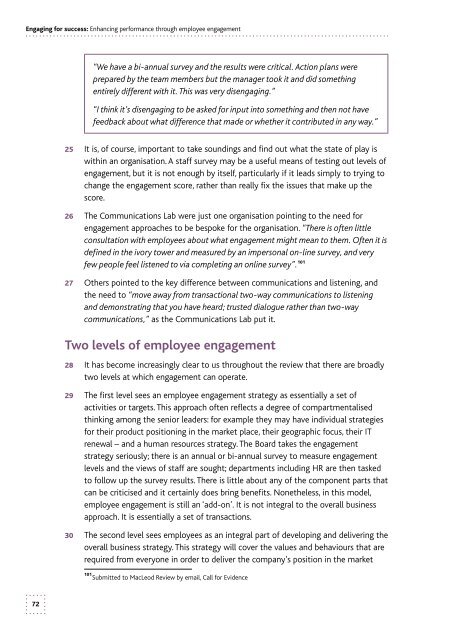3ytgeaf
3ytgeaf
3ytgeaf
Create successful ePaper yourself
Turn your PDF publications into a flip-book with our unique Google optimized e-Paper software.
Engaging for success: Enhancing performance through employee engagement<br />
“We have a bi-annual survey and the results were critical. Action plans were<br />
prepared by the team members but the manager took it and did something<br />
entirely different with it. This was very disengaging.”<br />
“I think it’s disengaging to be asked for input into something and then not have<br />
feedback about what difference that made or whether it contributed in any way.”<br />
25 It is, of course, important to take soundings and find out what the state of play is<br />
within an organisation. A staff survey may be a useful means of testing out levels of<br />
engagement, but it is not enough by itself, particularly if it leads simply to trying to<br />
change the engagement score, rather than really fix the issues that make up the<br />
score.<br />
26 The Communications Lab were just one organisation pointing to the need for<br />
engagement approaches to be bespoke for the organisation. “There is often little<br />
consultation with employees about what engagement might mean to them. Often it is<br />
defined in the ivory tower and measured by an impersonal on-line survey, and very<br />
few people feel listened to via completing an online survey”. 101<br />
27 Others pointed to the key difference between communications and listening, and<br />
the need to “move away from transactional two-way communications to listening<br />
and demonstrating that you have heard; trusted dialogue rather than two-way<br />
communications,” as the Communications Lab put it.<br />
Two levels of employee engagement<br />
28 It has become increasingly clear to us throughout the review that there are broadly<br />
two levels at which engagement can operate.<br />
29 The first level sees an employee engagement strategy as essentially a set of<br />
activities or targets. This approach often reflects a degree of compartmentalised<br />
thinking among the senior leaders: for example they may have individual strategies<br />
for their product positioning in the market place, their geographic focus, their IT<br />
renewal – and a human resources strategy. The Board takes the engagement<br />
strategy seriously; there is an annual or bi-annual survey to measure engagement<br />
levels and the views of staff are sought; departments including HR are then tasked<br />
to follow up the survey results. There is little about any of the component parts that<br />
can be criticised and it certainly does bring benefits. Nonetheless, in this model,<br />
employee engagement is still an ‘add-on’. It is not integral to the overall business<br />
approach. It is essentially a set of transactions.<br />
30 The second level sees employees as an integral part of developing and delivering the<br />
overall business strategy. This strategy will cover the values and behaviours that are<br />
required from everyone in order to deliver the company’s position in the market<br />
101<br />
Submitted to MacLeod Review by email, Call for Evidence<br />
72


